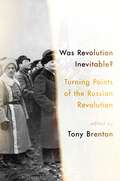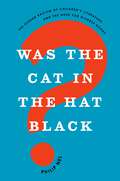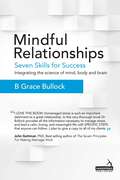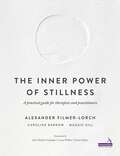- Table View
- List View
Transitioning Together: One Couple's Journey of Gender and Identity Discovery
by Beatrice M. Lawson Dr Wenn LawsonThis heartfelt, honest memoir tracks Wenn Lawson's transition from female to male and the effect it had on his relationship. Co-written by Wenn and his partner, Beatrice, the book explores the highs and lows of their journey and how they arrived at a point of acceptance and celebration of their individual identities and identity as a couple.
Treating Body and Soul: A Clinicians' Guide to Supporting the Physical, Mental and Spiritual Needs of Their Patients
by Bobbie Farsides Andy Nutall Cathy Garland Muna Al-Jawad Nicola Gainsborough Nigel Spencer Pat Shields Peter Larson-Disney Rachel Reed Somnath Mukhopadhyay Tim Ojo Jo DeBono Adam MacDiarmaid-GordonIn this book, healthcare professionals share their experiences of enquiring into the spiritual needs of their patients. Each using their own style of research, they discover that recognising patients' spiritual requirements allows the whole team to improve the level of care provided in a variety of medical settings.
The Trouble with Illness: How Illness and Disability Affect Relationships
by Julia SegalA candid look at how people respond when someone close to them has an illness or disability, and what can be done to avoid discomfort causing a rift in that relationship. The book explores relationships between partners, children and professionals and considers the different ways in which understanding can transform how people feel and react.
Unclouded by Longing: Meditations on Autism and Being Present in an Overwhelming World
by Christopher GoodchildMapped out in thoughtful, visionary prose, this book lights the way to clear-sighted, peaceful living. Informed by a combination of eastern and western philosophy, faith and the experiences of an author with autism, it examines the emotional challenges of modern life, and how to overcome them to live freely and tenderly.
Understanding Behaviour in Dementia that Challenges, Second Edition: A Guide to Assessment and Treatment
by Ian Andrew James Louisa JackmanRecent revisions of the Newcastle Challenging Behaviour Model have prompted the second edition of this guide to assessing and treating a range of behaviours when caring for older people with dementia. New material includes the use of physical restraint during personal care, lies and deception, end of life issues, and racism towards care staff.
Understanding Sensory Processing Disorders in Children: A Guide for Parents and Professionals
by Matt MielnickA clear and concise introduction to the sensory system, highlighting how it can differ in children. Using professional observation reports as examples, the book demonstrates how differing sensory thresholds affect the behaviour of children and gives practical recommendations for each case.
Unearthing Shakespeare: Embodied Performance and the Globe
by Valerie Clayman PyeWhat can the Globe Theatre tell us about performing Shakespeare?Unearthing Shakespeare is the first book to consider what the Globe, today’s replica of Shakespeare’s theatre, can contribute to a practical understanding of Shakespeare’s plays. Valerie Clayman Pye reconsiders the material evidence of Early Modern theatre-making, presenting clear, accessible discussions of historical theatre practice; stages and staging; and the relationship between actor and audience. She relays this into a series of training exercises for actors at all levels.From "Shakesball" and "Telescoping" to Elliptical Energy Training and The Radiating Box, this is a rich set of resources for anyone looking to tackle Shakespeare with authenticity and confidence.The Open Access version of this book, available at http://www.taylorfrancis.com, has been made available under a Creative Commons Attribution-Non Commercial-No Derivatives (CC-BY-NC-ND) 4.0 license.
Using Solution Focused Practice with Adults in Health and Social Care
by Judith Milner Steve MyersAn essential introduction which shows you how to work in solution focused ways with people in all stages of adulthood, including those with illness, mental disability and emotional trauma. It includes example activities that can be used to guide service users to use their own strengths to realize their personal goals.
Values in Health and Social Care: An Introductory Workbook
by Ben Hannigan Andrew Todd Stephen Pattison Ray SamuriwoRich in case studies, practical activities and downloadable resources, this is a beginner's guide to how values are formed and developed in varying professional contexts across health and social care services. It invites the reader to reflect on their own values, and on how these define the quality of the care they deliver.
Vedic Palmistry: Hasta Rekha Shastra
by Andrew MasonCompact and concise information on how to determine health implications and life events using palmistry and Vedic wisdom.With a discussion of introductory level astrology and its integration with palmistry, no prior knowledge is required. An essential guide for anyone interested in Vedic wisdom, Ayurveda or yoga.
The Voice Book for Trans and Non-Binary People: A Practical Guide to Creating and Sustaining Authentic Voice and Communication
by Gillie Stoneham Matthew MillsTwo leading speech therapists in the field explain what voice and communication therapy can offer transgender and non-binary individuals and the interventions used. Each chapter features narratives of individuals transitioning, giving an account of their experience transferring voice and communication skills from the clinic to the real world.
Was Revolution Inevitable?: Turning Points of the Russian Revolution
by Tony BrentonCommunism's rise and eventual fall in Eastern Europe is one of the great stories of the 20th century. Within this context, the Russian Revolution's role and legacy overshadows all else. In Was Revolution Inevitable?, former British Ambassador to Russia Sir Tony Brenton has gathered essays by leading historians to trace the events that led to the overthrow of the Tsarist regime and to pinpoint moments when those events could have unfolded in a drastically different way. What would the world be like had Fanny Kaplan succeeded in assassinating Vladimir Lenin in 1918? What if the Bolsheviks had never imposed the brutal "War Communism" initiatives that devastated the Russian peasants? What if Rasputin had talked Nicholas II out of involvement in World War One, which effectively led to the Revolution and sealed the demise of the Romanov dynasty? Preeminent scholars, including Orlando Figes, Richard Pipes, Douglas Smith, and Martin Sixsmith, ruminate on these questions and many others, assembling a series of pivotal moments that reveal what might have gone differently, and, if so, what the repercussions would have been. The contributors take a variety of approaches, from imagining an alternate history, to carefully studying a precarious moment of contingency, to disproving popular imagined alternatives. All of the chapters, however, shed light on Lenin's rise to power and the proliferation of his agenda, while assessing the influence of the revolution's pivotal moments on Russian-and global-politics. Provocative and illuminating, Was Revolution Inevitable? provides an in-depth exploration of the conflict that for nearly a century has shaped world history. The Russian Revolution put totalitarian communism into power, fueled Nazism and the Second World War, and forged one of the West's greatest antagonists. Here is a book that scrutinizes how the past, present, and future of global history could have been remarkably different had the events of 1917 unfolded differently and in the process deepens our understanding of what did happen and why.
Was the Cat in the Hat Black?: The Hidden Racism of Children's Literature, and the Need for Diverse Books
by Philip NelRacism is resilient, duplicitous, and endlessly adaptable, so it is no surprise that America is again in a period of civil rights activism. A significant reason racism endures is because it is structural: it's embedded in culture and in institutions. One of the places that racism hides-and thus perhaps the best place to oppose it-is books for young people. Was the Cat in the Hat Black? presents five serious critiques of the history and current state of children's literature tempestuous relationship with both implicit and explicit forms of racism. The book fearlessly examines topics both vivid-such as The Cat in the Hat's roots in blackface minstrelsy-and more opaque, like how the children's book industry can perpetuate structural racism via whitewashed covers even while making efforts to increase diversity. Rooted in research yet written with a lively, crackling touch, Nel delves into years of literary criticism and recent sociological data in order to show a better way forward. Though much of what is proposed here could be endlessly argued, the knowledge that what we learn in childhood imparts both subtle and explicit lessons about whose lives matter is not debatable. The text concludes with a short and stark proposal of actions everyone-reader, author, publisher, scholar, citizen- can take to fight the biases and prejudices that infect children's literature. While Was the Cat in the Hat Black? does not assume it has all the answers to such a deeply systemic problem, its audacity should stimulate discussion and activism.
What Counsellors and Spiritual Directors Can Learn from Each Other: Ethical Practice, Training and Supervision
by Ruth Bridges Prof William West Lynette Harborne Dr Nikki Kiyimba Dr Valda Swinton Dr Phil Goss Revd Dr WilliamsThis new collection explores the intersection of spiritual direction and counselling. It considers the ways in which they can enhance each other to provide better therapeutic and pastoral care.
What to Do about Smearing: A Practical Guide for Parents and Caregivers of People with Autism, Developmental and Intellectual Disabilities
by Kate E. ReynoldsWith practical advice and examples of interventions, this supportive book presents positive ways to manage faecal smearing in children and adults with autism and developmental disabilities. Explaining the root causes of smearing for better understanding, this is a reassuring resource for families and professionals who experience smearing behaviour.
William Wobbly and the Mysterious Holey Jumper: A story about fear and coping
by Rosie Jefferies Sarah NaishSometimes William Wobbly gets very anxious. When he is anxious he'll often turn to chewing his jumper or hiding under his school desk. But luckily his mum knows how to help cope with those wobbly feelings. This is the perfect story for any child who struggles to cope when worried and with destructive coping mechanisms.
Words that Touch: How to Ask Questions Your Body Can Answer - 12 Essential 'Clean Questions' for Mind/Body Therapists
by Nicholas PoleA thorough analysis of the Clean Language technique that can be applied to a variety of mind and body therapies. Through numerous theories and practical case studies, the importance of language in therapeutic practices is revealed.
Yoga for Speech-Language Development
by Jessica A. Fitzpatrick Susan E. LongtinThis is the first book to present yogic practices and resources for enhancing speech-language development in young children from birth through to age 12. With easy-to-carry out exercises and demonstrative photographs throughout, this innovative approach can be used to improve a range of speech-language issues.
Finding the Health: Thoughts on Osteopathic Diagnosis and Treatment
by Robert LeverThe art of osteopathy has always been based on a body of anatomical and physiological theory and data but it has recently been expanded in exciting ways involving contemporary thinking in physics and biology that tell us more about disease causation and tissue function. This book brings these two fields of thinking together.The author is now recognised as deep thinker in the field of osteopathy and has developed an international following since the publication of his first book At the Still Point. He puts into clear and understandable prose the ideas and feelings that many osteopaths experience but find difficult to express.The application of concept, theory and, above all, principle, is the real challenge and it is by addressing these with penetration and relevance that the book allows the practitioner to 'find the health' rather than merely attempting to confront disease.
Mindful Relationships: Seven Skills for Success
by B Grace BullockHuman existence depends on relationships. Our brains rely on interconnected neural networks to function. Our minds relentlessly encode complex matrices of meaning to make sense of the world. And our physical and psychological development is contingent on the social bonds we share with others.Mindful Relationships: The Seven Skills for Success integrates the science of mind, body and brain to reveal how stress undermines these relationships, and what we can do about it.Chronic stress threatens our wellbeing and relationship success by creating systemic dysregulation of the mind, body and brain.This dysregulation leaves us relying on primal defense strategies like aggression and withdrawal, and inhibits key cognitive-behavioral capacities essential to relationship success such as accurate appraisal, effective coping, and coherent communication.The inspirational and accessible book introduces the BREATHE model - an evidence-rich approach that synthesizes the science of mind, body and brain to alleviate stress, increase self-awareness, self-regulation, and emotional intelligence, and cultivate resilient social bonds.These Seven Skills are essential tools for creating and maintaining a healthy, harmonious, and successful relationship with yourself and others.Filled with sound science, engaging stories and experiential exercises, this book is bound to change the way that you relate to your life and those in it.
Spine and Joint Articulation for Manual Therapists
by Giles Gyer Jimmy Michael Ben Calvert-PainterThe book focuses on the practical application of articulation and mobilisation techniques with clear explanations and visual support of the techniques. Techniques are described for all body regions. Most other books for therapists include only one chapter on these important techniques.This book covers a variety of best practise techniques for all areas of the body. Examples are given to show how to adapt the techniques with the patient in different positions. It also addresses the use of these techniques on children, the elderly and pregnant women.The mechanisms of each technique are explained with reference to the related anatomy and physiology. Information is also given to help the therapist use the techniques safely (for both themselves and their patients) by adapting their own stance and posture to get maximum effect with minimum effort.
The Inner Power of Stillness: A Practical Guide for Therapists and Practitioners
by Alexander Filmer-Lorch Margaret Anne Gill Caroline BarrowThe Inner Power of Stillness is not just another book about therapeutic presence, mindfulness and meditation. It explores and highlights the next evolutionary step, leading us beyond the already well-researched teachings of these topics, by looking at the multidimensional scale of stillness from an entirely different point of view.The focal point is the inner development by therapists, practitioners and teachers of the mainly dormant potential of stillness and the storage capacity of stillness-stimulus and imprints in our tissue/fascia, as well as their benefits, use and application in a treatment or teaching environment.The Inner Power of Stillness endeavours to illuminate the lost value of stillness for the therapist and practitioner both as a person and as a professional. The authors anchor the possibility of this inner evolution of the power of stillness to the latest research into tissue and cell memory.They introduce the concept of a potential new modality called 'stillness-memory', and build upon this new understanding a logical and practical framework in which science and philosophy truly inform each other.This opens up access to a much larger scale of new ideas and possibilities which, providing the transformative teachings they embody are put into practice, carry the potential for practitioners to be the best person and the best professional they can be, without compromising their own overall health and wellbeing.In-depth knowledge of how to arrive at this promising new modality, as well as how to apply it in everyday work and life, is at the heart of the book. It covers topics such as working from your inner power of stillness, the insightful self and, most importantly, the practitioner's toolkit.Some thought-provoking themes that might be of great value to therapists, teachers and practitioners who intend to dedicate some of their time to working for the greater good can be found at the end of the book, where consideration is given to a universal view of compassion and the solace that stillness can bring to people who are nearing the end of their life and final departure.The book concludes with a philosophical note acknowledging the timeless nature of ancient wisdom, and the ever more important relevance and role of the philosopher in our modern world today.The Inner Power of Stillness is a comprehensive guide for people working with people. It provides practical knowledge that will revolutionise the way practitioners help others:Working from a greater perspective, being aware of the whole as well as the parts, and responding to the cause and not only the effect.Working from an internal place of stillness.Innovative and practical exercises and techniques to dissolve friction/struggles in sustaining a state of authentic therapeutic presence, mindfulness and meditation.Simple exercises to help clients build long-term memory of stillness as a foundation for successful mindfulness and meditation practice.Includes Forewords from John Matthew Upledger, Lauren Walker and Charles Ridley
Integrative Pain Management: Massage, Movement, and Mindfulness Based Approaches
by Diana L. Thompson Marissa BrooksThis book provides an overview of pain mechanisms as currently understood, and details a variety of approaches to pain management used across a wide range of complementary disciplines. A final chapter integrates these body-based and mind-body approaches, and helps the clinician offer the most effective care for the patient.The first part of the book discusses pain symptoms and the ways in which pain is experienced by individual patients. This section deals with the anatomy and pathology of pain, and describes present views of what causes pain to occur and persist. Integrative care concepts are presented, emphasizing multi-disciplinary approaches to addressing pain.In the second part, expert contributors describe therapeutic approaches to addressing pain conditions and implementing self-care management options, specific to the various disciplines. When available, research supporting the evidence for these interventions is incorporated.In the last chapter, the editors model various care pathways based on these approaches to assist healthcare practitioners in deciding how to effectively co-manage pain, including guidance on when and where to refer.
101 Inclusive and SEN Maths Lessons: Fun Activities and Lesson Plans for Children Aged 3 – 11 (101 Inclusive And Sen Lessons Ser.)
by Claire Brewer Kate BradleyThese simple and creative lesson plans, created to teach the National Curriculum, gives you new ideas for teaching maths to inclusive classrooms. Encourage every child to achieve their best through the easily adaptable and fun activities.
5S Made Easy: A Step-by-Step Guide to Implementing and Sustaining Your 5S Program
by David ViscoFor decades, 5S practitioners have struggled with exactly how to implement and sustain a 5S program in their workplaces
























